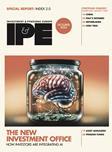Claire Smith
- Features
Pay-back time in Tokyo
For many, Japan was the surprise performer of the last 12 months, with a return of 49.6% over the fiscal year to March 2004. Most fund managers in the region anticipate strong earnings in the current year, driven by corporate structural reforms and a global and domestic cyclical recovery. Japan ...
- Features
Handling the mismatches
Matching of assets to liabilities should be the pension fund’s prime concern. For deferred liabilities and pensioners the matching asset class is evidently bonds, but few schemes own bonds with a maturity profile that matches the probable outflows of cash. At the long end there are few bonds available in ...
- Features
Growing case for diversifying widely
Greater diversification, a broader opportunity set and on average a higher information ratio might in summary be the case for allocating to global fixed income. If equity volatility wasn’t enough of an inducement, asset/liability modelling also favours bonds over equities. With low yields, and expensive domestic long bonds, investors are ...
- Features
Waiting for flight to quality
With a rise of 32% in the S&P500 from market lows it is fair to say that investor appetite for US equities has gone up since IPE’s last report on this market. But the overall market return figure disguises wide disparity in performance between sector, style and capitalisation bands. Whereas ...
- Features
Sectors have arrived
European institutions have little choice but to invest in European equities, be it via a domestic or foreign equity allocation, structured as a euro or pan-European mandate, or the European element of a global mandate. Four years after the birth of the euro, the means by which institutions achieve European ...
- Features
Burning at both ends
In essence there are two ways on investing in convertibles. One can buy a convertible outright and accept all the risks inherent within the instrument. The main risks are equity risk, for the bond may well convert into equity, credit risk, because as a debt instrument it is subject to ...
- Features
Lose your constraints
Claire Smith A couple of years ago, currency overlay mandates were fairly few and far between. Most pension funds left overseas currency exposures unhedged and those that did seek to manage them sought, in the main, to expunge the risk and accept the resulting profit or loss as simply part ...
- Features
Sharing the upside
Inherently the concept of performance fees is appealing. The plan sponsor only pays for performance when the manager delivers, and the manager has additional motivation to perform. However, a lower fee is poor compensation for cost of the poor performance it accompanies, and managers, in the pursuit of higher performance, ...
- Features
Uncertainty overhang holds back investors
Since Graham & Dodd published their paper on Securities Analysis in 1934 and T Rowe Price rejoined with a piece in Barron’s on investing for growth later that decade, the two contrasting styles of growth and value have competed for the high ground in US investment. For a European pension ...
- Features
Market with split personality
Investors in European equities enter this year with an even greater degree of uncertainty and foreboding than the last. Enormous risks overhang the market, not least the fear of war with Iraq, but also concerns over a double-dip recession and the need for structural reform in heavyweight markets like Germany. ...
- Features
Good for the long term
Investors, disenchanted with equities and suffering low yields on government bonds, are turning to corporate bonds in droves to access the historically high yield premium on which they are currently trading. European investors, deprived of the returns they traditionally made from trading between the legacy currencies, have taken advantage of ...





